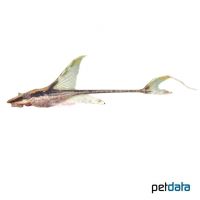Real Royal Farlowella (Sturisomatichthys festivum)
| Real Royal Farlowella Sturisomatichthys festivum | |
|---|---|
| Name | Real Royal Farlowella |
| Name Lat. | Sturisomatichthys festivum |
| Synonym | Sturisoma festivum |
| Family | Suckermouth Armoured Catfishes |
| Family lat. | Loricariidae |
| Order | Catfishes |
| Order lat. | Siluriformes |
| Origin | Colombia, Venezuela |
| Habitat | Tributaries, forest streams |
| Diet | Limnivore, soft wood |
| pH | 5.5-7.5 |
| Behavior | Peaceful |
| Keeping | Group |
| Care Level | Difficult |
| Reproduction | Substrate spawner |
| Breeding | Moderately difficult |
| Life Span | 8-12 years |
| Protection | No |
| Metric Units | |
| Size | 15-20 cm |
| Temperature | 24-26 °C |
| Hardness | 5-15 °dH |
| Aquarium | ~ 250 l |
| US Units | |
| Size | 6"-8" |
| Temperature | 75-79 °F |
| Hardness | 89-267 ppm |
| Aquarium | ~ 65 gal |
Distribution and habitat
The sailfin catfish are found in the watersheds of the Rio Catatumbo (Colombia) and the Rio Motatan (Venezuela). Their coloration and pattern is very variable. They live in jungle streams and rivers, prefers in the current between stones and dead wood and roots that protrude into the water.
Maintenance
The aquarium should have a loose planting, with stones as well as roots, which serve as a hiding place and at the same time are part of their diet. A substrate of round gravel, sufficient swimming space and oxygen-rich water with current is ideal.
No ammonia, ammonium and nitrite should be detectable, the nitrate value should not exceed 100 mg/l. To ensure the water quality and oxygen content, a filter and heater adapted to the aquarium size is required, as well as lighting for the species-appropriate day-night rhythm of the animals.
Diet
They eat the vegetable cover (growth) of stones, wood, plants, etc. and the microorganisms contained therein. For a balanced diet, feed once a day with a high-quality dry food for loricariid catfish (granules, pellets, chips, tablets), supplemented with algae leaves, soft wood and fresh vegetables, such as zucchini, broccoli, bruised peas or scalded spinach, plus occasional small amounts of zooplankton, cyclops, daphnia, artemia, mosquito larvae, etc. (live or frozen)
Feed only as much as will be eaten within a few minutes, excluding plant foods. Regular and varied feeding promotes health and increases resistance.
Behaviour and compatibility
They are diurnal fish. Several sailfin catfish should always be kept together. They are very peaceful within the species and towards other fish and can be socialized well with other calm fish.
Basically, only compatible fish species with similar requirements for water conditions and water temperature should be socialized
Sex dimorphism
Sexually mature males have bristles on both sides of the head.
Reproduction and breeding
They are so-called open brooders. The eggs are glued disc-shaped on a leaf, the aquarium glass or other substrate. The males guard the clutch. The larvae hatch after about 6 days and swim free after another 3 days.
Fry must be fed several times a day with special rearing food. In a community tank breeding is hardly possible, because the young fish are easy prey.
Important
They can also scrape off wood with their powerful sucking mouths, and they have intestinal flora that allows the fish to digest the cellulose
When catching them, use the finest mesh nets possible so that the hard rays of the pectoral fins or the skin teeth (odontodes) do not get caught on the bone plates, which can cause painful puncture wounds when touched.
The well-being of the fish should be checked regularly. Temperature should be checked daily, pH, hardness and nitrate levels at least every 14 days. Regular partial water changes are recommended, even when contaminant levels have not yet reached the upper limit. Sudden changes in water quality should be avoided. Newly introduced fish must be accustomed slowly to the water in the aquarium.
Further literature can be found in your pet store.
References
Text: Werner Winter; Image: petdata
Source: BMELV (1998): Tierschutzgutachten - Haltung von Zierfischen (Süßwasser); BAENSCH & RIEHL (2004): Aquarien Atlas Bd. 2, Mergus Verlag; ENGELMANN (2005): Zootierhaltung - Tiere in menschlicher Obhut: Fische, Verlag Harri Deutsch
- Gemäß § 21 Abs. 5 Tierschutzgesetz idgF
